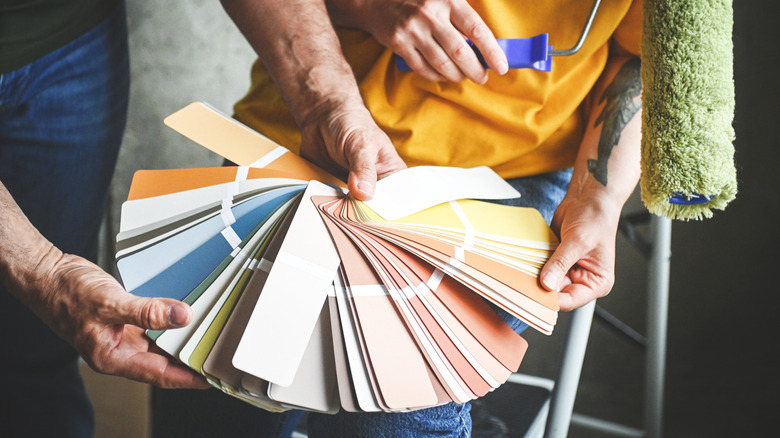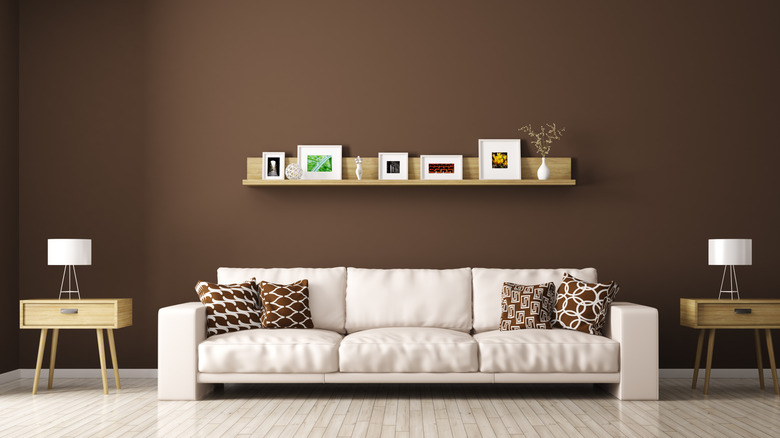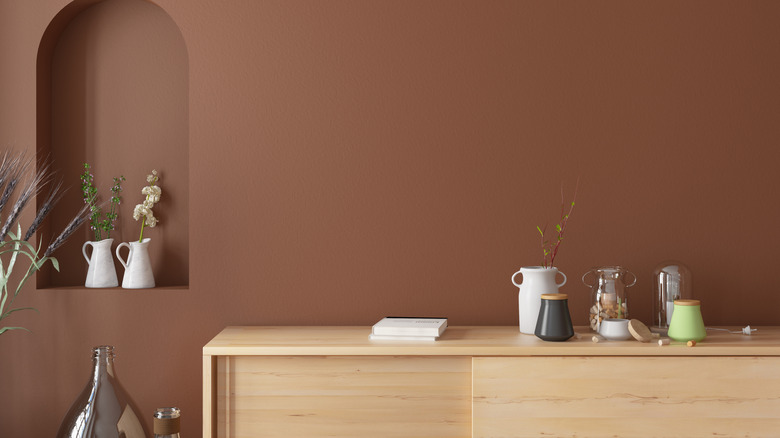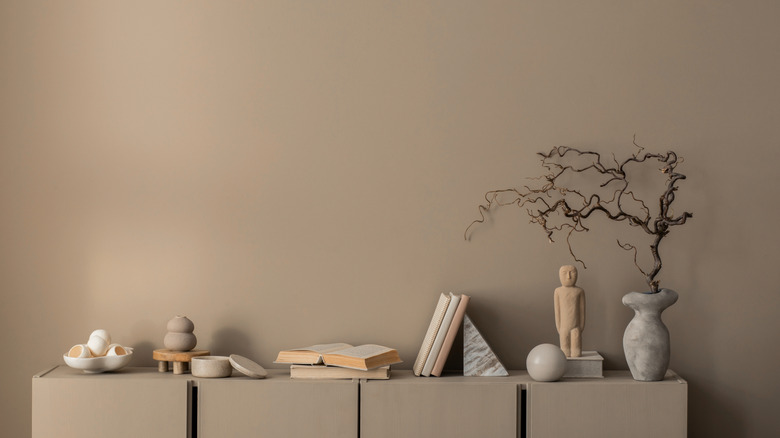The Calming Paint Trend That's Replacing Outdated Bold Accent Walls
While using an accent wall to liven up your home remains popular, the days of bold and vibrant ones may be at an end. Trends in the past have favored accent walls as a space to use bright spots of color and pattern, but a more subdued design trend is following, replacing these bolder shades with more muted colors and earth tones. At the forefront of these earthy shades is brown, which offers beautiful variations, including everything from rich chocolate to beautiful tans and beiges. Using these colors for your accent wall not only grounds the space but adds more depth subtle layers of color to your decorating scheme.
Accent walls are not only a way to set a color palette and aesthetics, but can be a perfect way to draw attention, directing the eye to the wall as a focal point or visually lengthening the space. They can also help keep the space light and bright but still have some color. Using colors drawn from nature not only helps avoid making your home look dated, but can lead to elevated and layered spaces that incorporate those earth tones with natural materials and materials like wood, greenery, and interesting textiles, like woven materials and suede. You can also combine brown with a host of other accent colors and other neutrals like cream, white, and gray with beautiful results.
Chocolate: the rich, dark brown
With current trends favoring darker colors, particularly as an accent wall shade, chocolate brown presents a warmer and cozier option to the popular blacks and charcoal grays. It sets the scene for great natural color combos, including with pretty grays, blues, and forest greens. Use it as a base for layering additional earth-toned furniture pieces, rugs, and décor in lighter shades of brown and taupe.
Dark browns, when combined with white or cream, are a great way to achieve a high-contrast effect that feels more elevated and timeless than monotone black and white. Combine it with rich, natural materials — like jute and bamboo — for a dramatic and contemporary look. Alternatively, velvet textile accents and gilt mirrors offer a dreamy and romantic vibe. For a cool mid century look, combine dark brown with shades of orange, gold, or avocado green. Beautiful options for paint include Sherwin Williams' Turkish Coffee; or if you prefer the cooler end of dark brown, Benjamin Moore's Rural Earth could work well.
Caramel: the spiced, warm brown
The warmth of a caramel accent wall is a great way to add comfort to otherwise cold or uninspiring, neutral spaces. Many designers consider caramel one of the "new neutrals," with variations ranging from lighter to deeper browns with warmer undertones. A light tone is a great way to add interest to a wall in a room that doesn't get a lot of natural sunlight, but where you still want to use a shade of medium brown. For a beautiful caramel brown, try Farrow & Ball's Wainscot.
Those undertones mean it pairs especially well with other, red-hued earth tones like terracotta, as well as with sunset-inspired colors like orange, yellow, and pink. Try a darker caramel accent with warmer textiles and furniture or use it as a backdrop for dark grays and chocolate browns for a monotone look. Caramel is an especially great earth tone for boho spaces with other neutrals and accents like hand-hewn pottery, colorful fabrics, and macrame. Caramels also look stunning with warm-toned woods, so combine well with elements on the wall like wood paneling, wainscotting, and other wood accents.
Tan: the cool light brown
One of the lightest shades in brown to use as an accent wall color, tan tends to have more neutral or cooler undertones, meaning you can take the room in many directions, including layering multiple browns and wood tones for a sophisticated look. It works perfectly if you want the room to remain on the lighter and brighter end, but still offers more depth than white or cream. Farrow & Balls' London Stone is a beautiful shade of tan to consider.
A popular color trend in the past couple years, tan is also a great shade to use as an accent wall through multiple rooms of your home for a sense of continuity, lending itself equally well to bathrooms and bedrooms as it does living rooms and dining rooms. Use it as a backdrop for ivory or cream furniture or combine it with jewel tones for a more maximalist look. Many homes are using shades of tan to achieve a revival of the Tuscan kitchen, a quirky kitchen style that is reemerging in popularity. Tan walls also give you a great opportunity to add texture to your walls with rag-painting, strié painting, sponging, and other faux painting techniques that incorporate two or more related shades.



